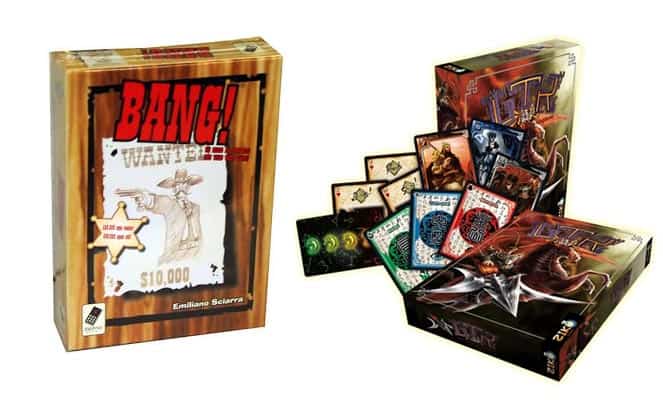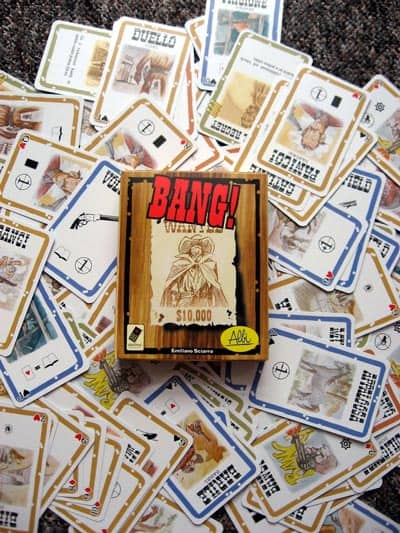Trending
Opinion: How will Project 2025 impact game developers?
The Heritage Foundation's manifesto for the possible next administration could do great harm to many, including large portions of the game development community.

Featured Blog | This community-written post highlights the best of what the game industry has to offer. Read more like it on the Game Developer Blogs or learn how to Submit Your Own Blog Post
Game lawyer Zachary Strebeck takes a look at the legal battle between the makers of the Bang! and Legend of the Three Kingdoms card games. This decision shows that judicial rulings on game copyright protection may be shifting in favor of more protection.



I don’t know how I missed this a few weeks ago, but the creator of the popular card game Bang!, DaVinci Editrice S.R.L., has filed a lawsuit against the creator and Western distributor of a similar card game, Legends of the Three Kingdoms. There has been a court ruling on a motion that contains lots of interesting info on how the court sees the issue before them.
This is going to be a long one, so strap in. We’ll talk about some of the latest legal developments in protecting game mechanics and rules from clones, using this case and others.
This court opinion is a response to the Defendants’ motion to dismiss the lawsuit. A motion to dismiss is made as a response to the initial complaint. This is a way to have the lawsuit dismissed before any of the really expensive lawyering begins.
In order to have this motion granted, the Defendant has to show that even if the facts and allegations in the complaint were taken as true, there would still be no valid claim. In this case, they would have to show that there was no valid claim of copyright infringement because none of the material supposedly infringed upon was eligible for copyright protection.
The court did not agree with the Defendants. Their ruling on the motion is a great read, that lays out the current state of copyright protection for both board games and video games. Any developer with an interest in the subject should check it out.


I’ve talked about several issues regarding copyright protection of board games before, from the idea/expression dichotomy to some discussion of potential infringement with Flappy Bird.
In the past, courts have not been very willing to give games any protection on the mechanical/rules side of things. Usually, all that is protectable by copyright is the artwork and the specific wording of the rules. While this is generally still accurate, this latest court opinion joins a few other recent ones that seem to be striking a balance between the “letter of the law” and a willingness to punish those who make “clone” games.
The court in the Bang! case was faced with a situation where the art and names of characters, roles and other important game concepts had all been changed. However, the two games are mechanically identical, down to the specific powers that the character counterparts had in the two games. Each role or character in Bang! has an analogous role or character in LoTK.
Going by case law in the past (and this is how the Defendants argued it), DaVinci wouldn’t be able to show infringement. However, the court asked the important question, “what is protectable element expression and what is not, including because it is an unprotectable game rule?”
They looked at two other cases: the Spry Fox v. LOLApps Inc. “Triple Town v. Yeti Town” case and theTetris Holdings v. Xio Interactive case. Both of these cases are examples of a more progressive attitude toward punishing clone games.

In Tetris, the game Mino was a literal clone, nearly indistinguishable from Tetris. This presented a problem, according to the case, since “almost all expressive elements of a game are related in some way to the rules and functions of game play.” Those rules and functions, of course, are not protectable by copyright.
The makers of Mino made this argument, but the court begged to differ. They found that “the dimensions of the playing field, the display of `garbage’ lines, the appearance of `ghost’ or shadow pieces, the display of the next piece to fall, the change in color of the pieces when they lock with the accumulated pieces, and the appearance of squares automatically filling in the game board when the game is over” were eligible for protection, even though they were very much tied to the functionality of the game.
The Spry Fox court looked at the similarities between the Triple Town and Yeti Town games. Though the art is very different in both games, so much of the functionality of the two games is extremely similar. The court in Spry Fox held that the game’s “object hierarchy that progresse[d] from grass to bushes to trees to houses and beyond,” along with other parts of the game, were eligible for copyright protection.

The DaVinci opinion contains some great quotes about the two games and how protectable the functional elements of Bang! are from infringement. I’ll just post them in their entirety here:
The artistic depictions of the Monarch, Minister, Rebel, and Turncoat roles in LOTK clearly differ visually from the depictions of the corresponding roles in Bang!. But the characteristics and manner in which the characters interact, not merely the names and pictures used to depict them, are creative and expressive elements in a role-playing game and are protectable. The roles and interplay among the characters in LOTK resemble those in Bang! closely enough to give rise to a plausible infringement claim and defeat the motion to dismiss.
The driving forces behind the experience of a role-playing game are individual decisions and the interactions among the players. The creative methods a game designer uses to define and shape that experience are the expressive elements that are protectable under [copyright] law.
Again, this is only the first stage of trial. There is a long way to go, assuming that the parties don’t settle. The opinion of the court here only had to find that there was a plausible claim of infringement. The decision may not turn in their favor, but it seems that the court is certainly aware of the cloning issue and these three cases are showing a positive direction for giving legal options to the victims of cloners.
If you’d like to read more about this case, check out Geek Dad’s post on the subject for an interesting take on the potential effects of greater copyright protection for games. Also, check out this article by Sam Castree about videogame copyright in general.
Read more about:
Featured BlogsYou May Also Like